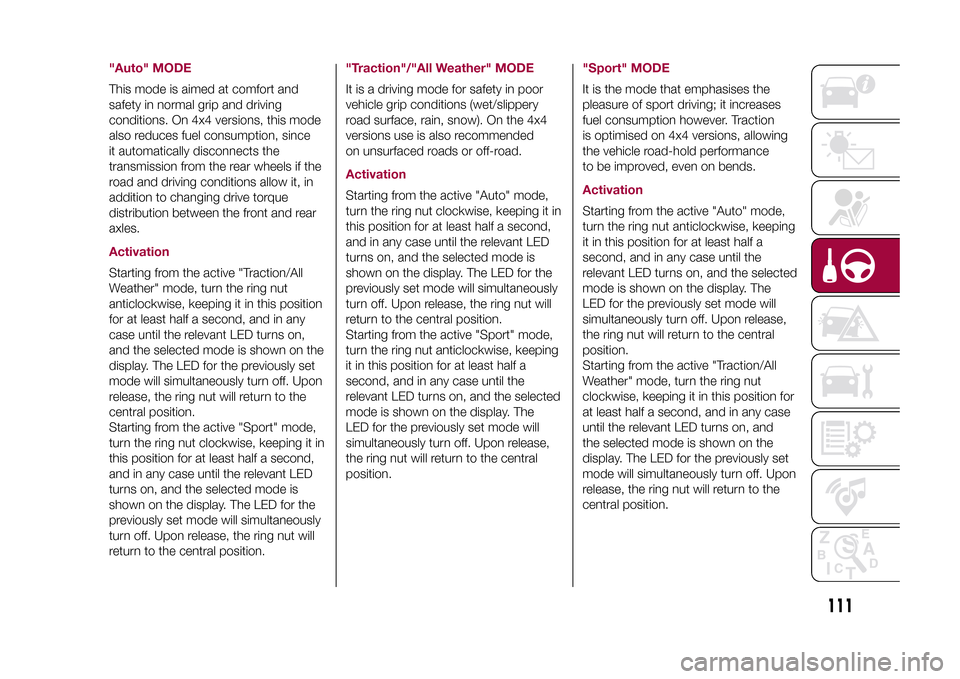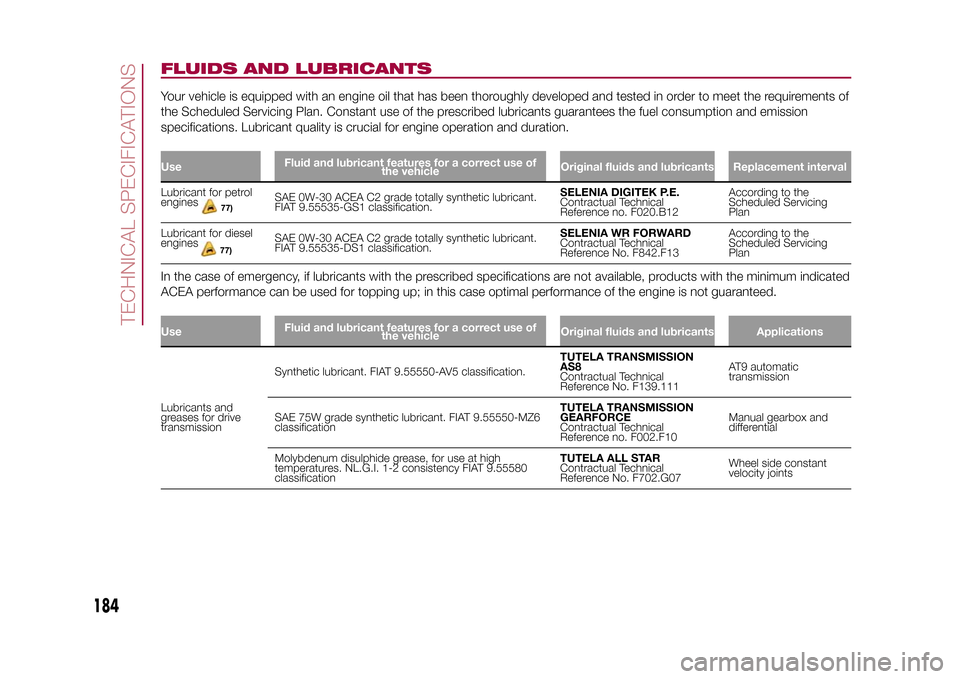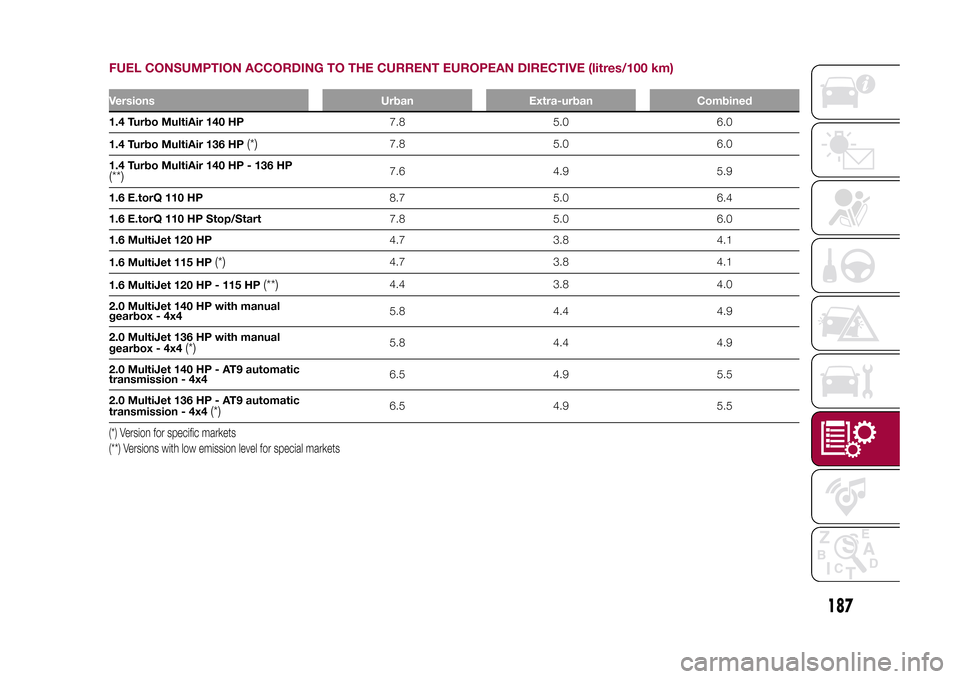2015 FIAT 500X fuel consumption
[x] Cancel search: fuel consumptionPage 43 of 240

DISPLAYDESCRIPTIONThe vehicle is equipped with a display
that can show useful information to the
driver while driving.
The display fig. 52 will show the
following information:❒A: time, Gear Shift Indicator (where
provided), gear engagement (versions
with automatic transmission only),
outside temperature, compass
indications (where provided), date.
❒B: vehicle speed, warning
messages/any failure indications.
❒C: total kilometres (or miles) run and
icons of any failure indications.
GEAR SHIFT INDICATOR(where provided)
The Gear Shift Indicator (GSI) system
advises the driver when to change gear
through a special indication on the
display
Through the GSI, the driver is informed
that the gear change will allow a
reduction in fuel consumption to be
obtained.
When the SHIFT UP icon (
SHIFT) is
shown on the display, the GSI is
advising the driver to engage a higher
gear, while the SHIFT DOWN (
SHIFT)
icon advises the driver to engage a
lower gear.
The indication in the display remains
until a gear is shifted or the driving
conditions go back to a situation where
gearshifting is not required to improve
consumption.
CONTROL BUTTONSThese are located on the left side of the
steering wheel fig. 53.
They allow the driver to select and
interact with the items in the Main menu
of the display (see paragraph "Main
menu").
❒
/
: press and release the
buttons to access the Main menu and
to scroll the menu and the submenus
upwards or downwards.
❒
/
: press and release the
buttons to access the information
displays or the submenus of an item of
the Main menu.
❒OK: press this button to access/
select the info displays or the
submenus of an item of the Main menu.
Hold the button pressed for 1 second
to reset the displayed/selected
functions.
08:30
KM/H
120
22°C
04/07/2014
1230km
52
F1B0179C
53
F1B0183C
41
15-12-2014 8:23 Pagina 41
Page 49 of 240

Warning light What it means
iTPMS
iTPMS failure
The warning light switches on when a failure is detected in the iTPMS. Should one or more wheels be fitted
without sensors, the display will show a warning message until initial conditions are restored.
IMPORTANT Do not continue driving with one or more flat tyres as handling may be compromised. Stop
the vehicle, avoiding sharp braking and steering. Repair immediately using the dedicated tyre repair kit (see
the “Fix&Go automatic kit” paragraph in the "In an emergency" chapter) and contact a Fiat Dealership as
soon as possible.
Tyre pressure low
The warning light switches on and a message is displayed to indicate that the tyre pressure is lower than
the recommended value and/or that slow pressure loss is occurring. In these cases, optimal tyre duration
and fuel consumption may not be guaranteed.
Should two or more tyres be in the condition mentioned above, the display will show the indications
corresponding to each tyre.
In any situation in which the dedicated message is shown on the display, it is ESSENTIAL to refer to the
contents of the "Wheels" paragraph in the "Technical data" chapter, strictly complying with the indications
that you find there.
In any situation in which the dedicated message is shown on the display, the sequence of indications
corresponding to each tyre.ABS FAILURE
The warning light switches on to indicate an ABS fault. In this case the braking system will work as normal,
but without the extra performance offered by the ABS. Drive carefully and contact a Fiat Dealership as
soon as possible.
47
15-12-2014 8:23 Pagina 47
Page 76 of 240

58)The system is an aid for the driver, who
must always pay full attention while driving.
The responsibility always rests with the
driver, who must take into account the
traffic conditions in order to drive in
complete safety. The driver must always
maintain a safe distance from the vehicle in
front.
59)If the driver depresses the brake pedal
fully or carries out a fast steering during
system operation, the automatic braking
function may stop (e.g. to allow a possible
manoeuvre to avoid the obstacle).
60)The system intervenes on vehicles
travelling in the same lane. People, animals
and things (e.g. pushchairs) are not taken
into consideration.
61)If the vehicle must be placed on a roller
bench for maintenance interventions or if
it is washed in an automatic roller washing
tunnel with an obstacle in the front part
(e.g. another vehicle, a wall or another
obstacle), the system may detect its
presence and activate. In this case the
system must be deactivated through the
settings of theUconnect™system.
62)If the system signals a pressure
decrease on a specific tyre, it is
recommended to check the pressure on all
four tyres.
63)iTPMS does not relieve the driver from
the obligation to check the tyre pressure
every month; it is not to be considered
a system to replace maintenance or a
safety system.64)Tyre pressure must be checked with
tyres cold. Should it become necessary for
whatever reason to check pressure with
warm tyres, do not reduce pressure even if
it is higher than the prescribed value,
rather repeat the check when tyres are
cold.
65)The iTPMS cannot indicate sudden tyre
pressure drops (e.g. if a tyre bursts). In
this case, stop the vehicle, braking with
caution and avoiding abrupt steering.
66)The system only warns that the tyre
pressure is low: it is not able to inflate
them.
67)Insufficient tyre inflation increases fuel
consumption, reduces the tread duration
and may affect the capacity to drive safely.
WARNING
22)The system may have limited or absent
operation due to weather conditions such
as: heavy rain, hail, thick fog, heavy snow.
23)The section of the bumper before
the sensor must not be covered with
adhesives, auxiliary headlights or any other
object.
24)System intervention might be
unexpected or delayed when other vehicles
transport loads projecting from the side,
above or from the rear, with respect to the
normal size of the vehicle.
25)Operation can be adversely affected by
any structural change made to the vehicle,
such as a modification to the front
geometry, tyre change, or a heavier load
than the standard load of the vehicle.26)Incorrect repairs made on the front part
of the vehicle (e.g. bumper, chassis) may
alter the position of the radar sensor,
and adversely affect its operation. Go to a
Fiat Dealership for any operation of this
type.
27)Do not tamper with nor carry out any
intervention on the radar sensor or on
the camera on the windscreen. In the event
of a sensor failure, contact a Fiat
Dealership.
28)When towing a trailer (with modules
installed after purchasing the vehicle),
a vehicle or during loading manoeuvres on
a vehicle transporter (or in vehicle for
transport), the system must be deactivated
via theUconnect™system.
29)Do not wash with high-pressure jets in
the bumper lower area: in particular do
not operate on the system's electrical
connector.
30)Be careful in the case of repairs and
new paintings in the area around the
sensor (panel covering the sensor on the
left side of the bumper). In the event of
a frontal impact the sensor may
automatically deactivate and display a
warning to indicate that the sensor needs
to be repaired. Even without a malfunction
warning, deactivate the system operation
if you think that the position of the radar
sensor has changed (e.g. due to
low-speed frontal impact as during parking
manoeuvres). In these cases, go to a Fiat
Dealership to have the radar sensor
realigned or replaced.
74
SAFETY
15-12-2014 8:23 Pagina 74
Page 113 of 240

"Auto" MODEThis mode is aimed at comfort and
safety in normal grip and driving
conditions. On 4x4 versions, this mode
also reduces fuel consumption, since
it automatically disconnects the
transmission from the rear wheels if the
road and driving conditions allow it, in
addition to changing drive torque
distribution between the front and rear
axles.ActivationStarting from the active "Traction/All
Weather" mode, turn the ring nut
anticlockwise, keeping it in this position
for at least half a second, and in any
case until the relevant LED turns on,
and the selected mode is shown on the
display. The LED for the previously set
mode will simultaneously turn off. Upon
release, the ring nut will return to the
central position.
Starting from the active "Sport" mode,
turn the ring nut clockwise, keeping it in
this position for at least half a second,
and in any case until the relevant LED
turns on, and the selected mode is
shown on the display. The LED for the
previously set mode will simultaneously
turn off. Upon release, the ring nut will
return to the central position.
"Traction"/"All Weather" MODEIt is a driving mode for safety in poor
vehicle grip conditions (wet/slippery
road surface, rain, snow). On the 4x4
versions use is also recommended
on unsurfaced roads or off-road.ActivationStarting from the active "Auto" mode,
turn the ring nut clockwise, keeping it in
this position for at least half a second,
and in any case until the relevant LED
turns on, and the selected mode is
shown on the display. The LED for the
previously set mode will simultaneously
turn off. Upon release, the ring nut will
return to the central position.
Starting from the active "Sport" mode,
turn the ring nut anticlockwise, keeping
it in this position for at least half a
second, and in any case until the
relevant LED turns on, and the selected
mode is shown on the display. The
LED for the previously set mode will
simultaneously turn off. Upon release,
the ring nut will return to the central
position.
"Sport" MODEIt is the mode that emphasises the
pleasure of sport driving; it increases
fuel consumption however. Traction
is optimised on 4x4 versions, allowing
the vehicle road-hold performance
to be improved, even on bends.ActivationStarting from the active "Auto" mode,
turn the ring nut anticlockwise, keeping
it in this position for at least half a
second, and in any case until the
relevant LED turns on, and the selected
mode is shown on the display. The
LED for the previously set mode will
simultaneously turn off. Upon release,
the ring nut will return to the central
position.
Starting from the active "Traction/All
Weather" mode, turn the ring nut
clockwise, keeping it in this position for
at least half a second, and in any case
until the relevant LED turns on, and
the selected mode is shown on the
display. The LED for the previously set
mode will simultaneously turn off. Upon
release, the ring nut will return to the
central position.
111
15-12-2014 8:23 Pagina 111
Page 174 of 240

TECHNICAL SPECIFICATIONS
Everything you may find useful for
understanding how your vehicle
is made and works is contained in this
chapter and illustrated with data, tables
and graphics. For the enthusiasts and
the technician, but also just for those
who want to know every detail of their
vehicle.IDENTIFICATION DATA....................173
ENGINE ..........................................174
WHEELS .........................................176
DIMENSIONS ..................................178
WEIGHTS........................................180
SUPPLIES .......................................182
FLUIDS AND LUBRICANTS ............184
PERFORMANCE .............................186
FUEL CONSUMPTION ....................186
CO2 EMISSIONS ............................188
PRESCRIPTIONS FOR HANDLING
THE VEHICLE AT THE END OF ITS
LIFE ................................................189
172
TECHNICAL SPECIFICATIONS
15-12-2014 8:23 Pagina 172
Page 186 of 240

FLUIDS AND LUBRICANTSYour vehicle is equipped with an engine oil that has been thoroughly developed and tested in order to meet the requirements of
the Scheduled Servicing Plan. Constant use of the prescribed lubricants guarantees the fuel consumption and emission
specifications. Lubricant quality is crucial for engine operation and duration.UseFluid and lubricant features for a correct use of
the vehicleOriginal fluids and lubricants Replacement intervalLubricant for petrol
enginesSAE 0W-30 ACEA C2 grade totally synthetic lubricant.
FIAT 9.55535-GS1 classification.SELENIA DIGITEK P.E.
Contractual Technical
Reference no. F020.B12According to the
Scheduled Servicing
Plan
Lubricant for diesel
engines
77)
SAE 0W-30 ACEA C2 grade totally synthetic lubricant.
FIAT 9.55535-DS1 classification.SELENIA WR FORWARD
Contractual Technical
Reference No. F842.F13According to the
Scheduled Servicing
Plan
In the case of emergency, if lubricants with the prescribed specifications are not available, products with the minimum indicated
ACEA performance can be used for topping up; in this case optimal performance of the engine is not guaranteed.UseFluid and lubricant features for a correct use of
the vehicleOriginal fluids and lubricants ApplicationsLubricants and
greases for drive
transmissionSynthetic lubricant. FIAT 9.55550-AV5 classification.TUTELA TRANSMISSION
AS8
Contractual Technical
Reference No. F139.111AT9 automatic
transmission
SAE 75W grade synthetic lubricant. FIAT 9.55550-MZ6
classificationTUTELA TRANSMISSION
GEARFORCE
Contractual Technical
Reference no. F002.F10Manual gearbox and
differential
Molybdenum disulphide grease, for use at high
temperatures. NL.G.I. 1-2 consistency FIAT 9.55580
classificationTUTELA ALL STAR
Contractual Technical
Reference No. F702.G07Wheel side constant
velocity joints
184
TECHNICAL SPECIFICATIONS
15-12-2014 8:23 Pagina 184
77)
Page 188 of 240

PERFORMANCETop speed reachable after the initial period of usage of the vehicle.
Versions km/h
1.4 Turbo MultiAir 140 HP190
1.4 Turbo MultiAir 136 HP
(*)
187
1.6 E.torQ180
1.6 MultiJet 120 HP186
1.6 MultiJet 115 HP
(*)
183
2.0 MultiJet 140 HP with manual gearbox - 4x4190
2.0 MultiJet 136 HP with manual gearbox - 4x4
(*)
187
2.0 MultiJet 140 HP AT9 automatic transmission - 4x4190
2.0 MultiJet 136 HP - AT9 automatic transmission - 4x4
(*)
187
(*) Version for specific marketsFUEL CONSUMPTIONThe fuel consumption values given in the table below are determined on the basis of the type-approval tests laid down by
specific European Directives. The procedures below are followed for measuring consumption:
❒urban cycle: cold starting followed by driving that simulates urban use of the vehicle;
❒extra-urban cycle: frequent accelerating in all gears, simulating extra-urban use of the vehicle: speed varies between 0 and
120 km/h;
❒combined fuel consumption: calculated with a weighting of approximately 37% of the urban cycle and 63% of the extra-
urban cycle.
IMPORTANT The type of route, traffic situations, weather conditions, driving style, general conditions of the car, trim level/
equipment/accessories, load, climate control system, roof rack, other situations that affect air drag may lead to different fuel
consumption levels than those measured. The fuel consumption will get more regular only after having driven the first 3000 km.
186
TECHNICAL SPECIFICATIONS
15-12-2014 8:23 Pagina 186
Page 189 of 240

FUEL CONSUMPTION ACCORDING TO THE CURRENT EUROPEAN DIRECTIVE (litres/100 km)Versions Urban Extra-urban Combined1.4 Turbo MultiAir 140 HP7.8 5.0 6.0
1.4 Turbo MultiAir 136 HP
(*)
7.8 5.0 6.0
1.4 Turbo MultiAir 140 HP - 136 HP
(**)
7.6 4.9 5.9
1.6 E.torQ 110 HP8.7 5.0 6.4
1.6 E.torQ 110 HP Stop/Start7.8 5.0 6.0
1.6 MultiJet 120 HP4.7 3.8 4.1
1.6 MultiJet 115 HP
(*)
4.7 3.8 4.1
1.6 MultiJet 120 HP - 115 HP
(**)
4.4 3.8 4.0
2.0 MultiJet 140 HP with manual
gearbox - 4x45.8 4.4 4.9
2.0 MultiJet 136 HP with manual
gearbox - 4x4
(*)
5.8 4.4 4.9
2.0 MultiJet 140 HP - AT9 automatic
transmission - 4x46.5 4.9 5.5
2.0 MultiJet 136 HP - AT9 automatic
transmission - 4x4
(*)
6.5 4.9 5.5
(*) Version for specific markets
(**) Versions with low emission level for special markets
187
15-12-2014 8:23 Pagina 187